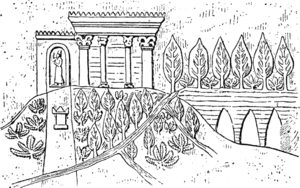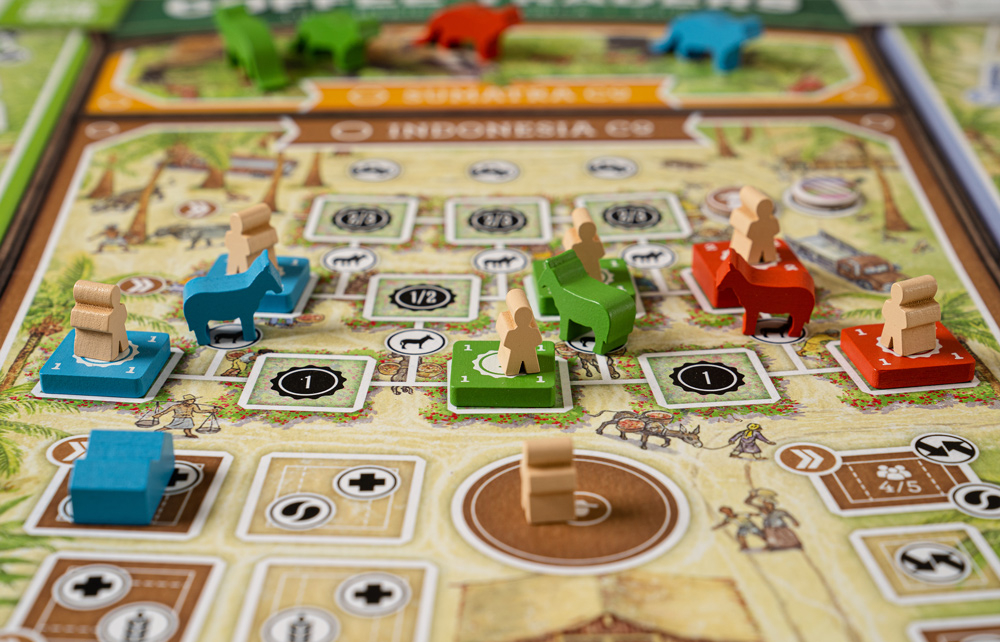Историческое существование

На этой копии из Северного дворца Ашшурбанипала (669–631 гг. До н.э.) в Ниневии изображен роскошный сад, орошаемый акведуком.
Неясно, были ли Висячие сады реальным сооружением или поэтическим творением из-за отсутствия документации в современных вавилонских источниках. Также нет упоминания о жене Навуходоносора Амитис (или любых других женах), хотя политический брак с мидянином или персом не был бы необычным. Существует множество записей о работах Навуходоносора, однако в его длинных и полных надписях не упоминается ни один сад. Однако считается, что сады все еще существуют в то время, когда их описывали более поздние авторы, и некоторые из этих рассказов считаются происходящими от людей, которые посетили Вавилон. Геродот , описывающий Вавилон в « Истории» , не упоминает Висячие сады, хотя, возможно, эти сады еще не были хорошо известны грекам во время его визита.
На сегодняшний день в Вавилоне не было обнаружено никаких археологических свидетельств Висячих садов. Возможно, существуют доказательства под Евфратом, которые в настоящее время невозможно безопасно раскопать. Река текла к востоку от своего нынешнего положения во времена Навуходоносора II, и мало что известно о западной части Вавилона. Роллингер предположил, что Берос приписал Сады Навуходоносору по политическим причинам и что он заимствовал легенду откуда-то еще.
Controversy
Stone tablets from Nebuchadnezzar’s reign give detailed descriptions of the city of Babylonia, its walls, and the palace, but do not refer to the Hanging Gardens. Today, some historians make the case that the Hanging Gardens of Babylon never actually existed.
Image of a “Hanging Garden” from an Assyrian tablet.
They stake their claims on the fact that the warriors in the army of Alexander the Great were amazed at the immense prosperity of the thriving city of Babylon and tended to exaggerate their experiences greatly. When the soldiers returned to their stark homeland, they had incredible stories to relate about the remarkable gardens, palm trees, and imposing buildings of rich and fertile Mesopotamia. This was, after all, the land of Nebuchadnezzar’s fabulous palace, the great Ishtar Gate, the legendary Tower of Babel, and other pyramid-like ziggurats. When all of these extraordinary architectural elements were combined together in the imagination of the poets, scholars, and historians of Ancient Greece, the result was another, although fictional, World Wonder. Others point to Assyrian tablets showing raised “hanging” gardens from the city of Nineveh, raising the possibility that the Babylonian gardens may be exaggerated, fanciful versions of what existed in another major Mesopotamian city.
Twentieth century archaeologists began collecting evidence about unsolved questions concerning the Hanging Gardens: What was their location? What kind of irrigation system did it have? What did the Hanging Gardens actually look like? These questions have yet to be fully answered.
Download the Hanging Gardens of Babylon Facts & Worksheets
Click the button below to get instant access to these worksheets for use in the classroom or at a home.
Download This Worksheet
This download is exclusively for KidsKonnect Premium members!To download this worksheet, click the button below to signup (it only takes a minute) and you’ll be brought right back to this page to start the download!Sign Me Up
Already a member? Log in to download.
Edit This Worksheet
Editing resources is available exclusively for KidsKonnect Premium members.To edit this worksheet, click the button below to signup (it only takes a minute) and you’ll be brought right back to this page to start editing!Sign Up
Already a member? Log in to download.
Credits
New World Encyclopedia writers and editors rewrote and completed the Wikipedia article
in accordance with New World Encyclopedia standards. This article abides by terms of the Creative Commons CC-by-sa 3.0 License (CC-by-sa), which may be used and disseminated with proper attribution. Credit is due under the terms of this license that can reference both the New World Encyclopedia contributors and the selfless volunteer contributors of the Wikimedia Foundation. To cite this article click here for a list of acceptable citing formats.The history of earlier contributions by wikipedians is accessible to researchers here:
Hanging Gardens of Babylon history
The history of this article since it was imported to New World Encyclopedia:
History of “Hanging Gardens of Babylon”
Note: Some restrictions may apply to use of individual images which are separately licensed.
Archaeological Theories
Recent archaeological digs at Babylon have unearthed a major palace, a vaulted building with thick walls (perhaps the one mentioned by Greek historians), and an irrigation well in proximity to the palace. Although an archaeological team surveyed the palace site and presented a reconstruction of the vaulted building as being the actual Hanging Gardens, accounts by Strabo place the Hanging Gardens at another location, nearer the Euphrates River. Other archaeologists insist that since the vaulted building is thousands of feet from the Euphrates, it is too distant to support the original claims even if Strabo happened to be wrong about the location. The latter team reconstructed the site of the palace, placing the Hanging Gardens in a zone running from the river to the palace. Interestingly, on the banks of the Euphrates, a newly discovered, immense, 82-foot thick wall may have been stepped to form terraces like those mentioned by the ancient Greek sources.
The Hanging Gardens of Nineveh?
Following a recent investigation, Oxford University Assyriologist Stephanie Dalley has argued that the Hanging Gardens were not built by King Nebuchadrezzar II in Babylon at all, but in Nineveh by the Assyrian ruler Sennacherib (r. 704-681 B.C.). Her thesis relies on the annals of his reign, which have been found inscribed on prism-shaped stones. In one the king boasts of the extensive monument-building he undertook: “I raised the height of the surroundings of the palace to be a Wonder for all peoples . . . A high garden imitating the Amanus mountains I laid out next to it with all kinds of aromatic plants.”
With its reference to wonder and height, the passage echoes many of the key aspects attributed to the Hanging Gardens. Just as classical writers referred to Babylon’s king imitating the landscape of Persia, Sennacherib’s annals detail the gardens’ imitation of Mount Amanus, a range in the extreme south of modern-day Turkey.
A relief from the time of Sennacherib’s grandson, Ashurbanipal (r. 668-627 B.C.), depicts gardens with trees distributed across a slope topped by a pavilion. Water flows from an aqueduct to feed a series of channels filled with fish. The theory that this Ninevan pleasure park could well have been the famed Hanging Gardens is bolstered further by Sennacherib’s reputation for engineering innovation. He declared himself to be of “clever understanding.” The archives of his reign abound with references to ingenious irrigation systems, and some historians credit him with the invention of the Archimedes water screw. Archaeologists have also found an aqueduct system, built during his reign from two million blocks of stone, that brought water to the city across the Jerwan valley. (See “extremely rare” Assyrian reliefs discovered in a canal system near ancient Nineveh.)
The Jerwan structure lies on the route to Alexander the Great’s decisive battle with the Persians, at Gaugamela, in 331 B.C. Dalley argues that it is likely Alexander saw the aqueduct as he passed Nineveh. His inquiries into the sophisticated water systems and gardens of that city seeded the story of the Hanging Gardens, which scholarly confusion then misattributed to Babylon. If the theory is true, it would solve a great archaeological mystery, and leave few in doubt that the Hanging Gardens of Nineveh were a wonder indeed.
Monumental confusion
The first-century A.D. Roman Jewish historian Josephus wrote that the gardens lay within Babylon’s main palace. During the first excavations of the ruins of Babylon, directed by the German archaeologist Robert Koldewey between 1899 and 1917, a robust, arched structure was unearthed in the northeast corner of the Southern Palace.
Koldewey believed that this was the very structure that had supported the famous gardens. It was made of carved stone, making it more resistant to moisture than mud brick. Its extremely thick walls would have been perfect for supporting the heavy superstructure. In addition, there was evidence of wells, which Koldewey assumed had formed part of the gardens’ irrigation system.
Today, however, most scholars agree that the building was probably a warehouse. Several storage jars were excavated from the site, but the strongest evidence is a cuneiform tablet unearthed there that dates to the time of Nebuchadrezzar II. The record contains details about the distribution of sesame oil, grain, dates, spices, and high-ranking captives. (This is how Koldewey and his team uncovered Nebuchadrezzar II’s vibrant Ishtar Gate.)
Koldewey’s excavation is most famous for revealing the foundations of a wondrous structure that really did exist: Babylon’s ziggurat, or stepped tower. A decade later, while British archaeologist Leonard Woolley was excavating the ancient Sumerian city of Ur to the southeast of Babylon, he noted regularly spaced holes in the brickwork of the ziggurat there. Might these be evidence of some kind of drainage or irrigation system supplying gardens rising up the face of the Ziggurat of Ur? Perhaps this kind of system, Woolley speculated, was later used to design the Hanging Gardens in Babylon. (Agatha Christie mended a broken heart through archaeology in Mesopotamia.)
Spurred, perhaps, by the lively public interest such a theory would awaken, Woolley embraced the theory. But archaeologists largely agree that his sober, initial assessment was correct: The holes were bored to enable the even drying of the brickwork during its construction.
Faced with this lack of documentary and archaeological evidence, some experts have opted for a radical reframing of the quest for the Hanging Gardens: What if they were not in Babylon at all? This wonder of the world could well be located in another city entirely.
This hypothesis is not as radical as it may appear at first: Greco-Roman sources that reference the Hanging Gardens tended to present historical detail interwoven with myth and legend, and their recounting of the history of great Mesopotamian civilizations often confused Assyria and Babylonia. Diodorus, for example, places Nineveh, the capital of the Assyrian Empire, next to the Euphrates, although in fact the city stood on the banks of the Tigris.
In another passage Diodorus describes the walls of Babylon, detailing its rich depiction of animals, hunted by “Queen Semiramis on horseback in the act of hurling a javelin at a leopard, and nearby her husband Ninus, in the act of thrusting his spear into a lion.” No such hunting scene has been found in Babylon. It does, however, correspond closely with neo-Assyrian hunting reliefs engraved on the stone walls of the Northern Palace in Nineveh.
Что особенно нравится в отеле

Спа-центр
Гостиничный комплекс Hanging Gardens of Bali высоко ценится туристами за высочайшее качество предоставляемых услуг, гостеприимство и приветливость персонала, невероятную красоту ландшафтов и уникальную атмосферу покоя и единения с природой.
Те, кто уже побывал там, могут поделиться впечатлениями на сайте ToursBali.
Посещение Висячих садов доступно и людям, не проживающим в нем. За определенную плату любой желающий может пообедать или поужинать в ресторане, сходить на процедуры в спа-центр или поплавать в центральном бассейне. Такой вариант отдыха пользуется большим спросом у приезжих, не готовых платить значительную сумму за номер в отеле.
С кем вы бы предпочли поехать в Висячие сады?
Вдвоем с супругой (супругом), женихом (невестой)
0%
Всей семьей с детьми и родителями
0%
В одиночку 0%
С компанией друзей
0%
Проголосовало:
More facts about the hanging gardens of Babylon
6. The word is derived from the Greek word “kremastós” which literally means “overhanging.” This has a broader meaning than just hanging and would refer to a garden that is elevated with its plants and trees overhanging the terraces they grew on.
7. There isn’t any reference to Nebuchadnezzar II having a Median wife named Amytis. Historians, however, concluded that this is very likely as strategical marriages with neighboring kingdoms or empires were quite common. This would support the theory that his Median wife was homesick and the gardens were constructed for her.
8. The city of Babylon was one of the marvels of the ancient world and was far ahead of its time. Greek historian “Herodotus,” wrote in 450 B.C. that “Babylon surpasses in splendor any city in the known world.”
9. The Hanging Gardens of Babylon have sometimes been described as the “Hanging Gardens of Semiramis.” She was a female Assyrian ruler who is believed to have extensively rebuilt Babylon in the 9th century B.C. Being a female reigning and being able to stabilize the empire during political unrest gave her a mythical status.Hanging Gardens of Semiramis / 19th-century painting by H. Waldeck / Wiki Commons
10. An interesting fact about the Hanging Gardens of Babylon is that the five writers who describe the gardens lived in a time that the gardens still existed. So this gives more credibility to the theory that they did in fact exist as they were able to derive their stories from people that actually visited Babylon at the time.
11. The hanging Garden of Nineveh did in fact exist as there are both writings and archeological evidence for them. Below is a drawing of the relief of the gardens found nearby that clearly show gardens being watered upwards with an irrigation system and aqueduct.

12. The canals that were used for irrigating the gardens of the Palace of Nineveh were made of limestone, were over 80 kilometers (50 mi) long, and went all up into the mountains. Humble as can be, he wrote this about them:
13. Excavations done at Nineveh have unearthed some of the aqueducts described by king Sennacherib. Recent unrest in the region (the area of Mosul in Iraq) makes it hard to investigate further.
14. Many historians believe that the gardens did exist, but have been destroyed by a combination of earthquakes, war, and erosion.
15. Many of the contemporary writers actually describe how the gardens looked like. Being able to describe in detail how the gardens appear gives the impression they got this info from people that actually saw the Hanging Gardens of Babylon. Diodorus Siculus, for instance, described the gardens as being 121 meters (400 ft) long and wide and over 24 meters (80 ft) high. That’s the size of 2 large football/soccer fields!
16. Robert Koldewey was a german archeologist who did a lot of work (from 1899 until 1917) on the excavations of the ancient city of Babylon. He believed he had found the gardens when he discovered a basement with stone arch ceilings. Ancient texts mentioned there were only two buildings that used stone, the citadel, and the gardens, and the citadel had already been found.Illustration of Babylon with its wall and palace inspired by early excavations / Wiki Commons
Modern-day archeologists have refuted his claim though as the basement he found is too far from the river Euphrates to be used as a source of water for the gardens.
17. It’s estimated that Babylon was one of the largest cities in the world from 1770 to 1670 B.C. and then again during the period the hanging gardens were supposedly built from 602 up until 320 B.C.
18. It’s also believed that Babylon was the first city in the world to ever reach a population of over 200,000 people, which would have been a massive amount in those times.
19. Babylon was located about 85 kilometers south of the modern-day capital of Iraq, Baghdad.
20. The Provincial government of Babil announced in 2009 that they would reopen the excavation site of the ruins of Babylon to tourists. Because of the ongoing unrest in the region, not many have come as of yet.Excavation site of the ancient city of Babylon / Wiki Commons
21. The Hanging Gardens of Babylon aren’t just one of the 7 wonders of the ancient world, the excavation site of the ancient city of Babylon (where the gardens are supposedly located) has been inscribed as a UNESCO World Heritage Site since July 5, 2019.Babylon excavation site as seen from Saddam Hussein’s summer palace / Wiki Commons
Растения
Финиковые пальмы – обычная порода деревьев в Вавилоне.
Сады, изображенные на произведениях искусства, были украшены цветущими цветами, спелыми фруктами, бурлящими водопадами и террасами, пышными густой листвой. Основываясь на вавилонской литературе, традициях и экологических характеристиках местности, в садах могли быть найдены некоторые из следующих растений:
- Olea europaea
- Cydonia oblonga
- Pyrus communis
- Фикус карика
- Prunus dulcis
- Vitis vinifera
- Phoenix dactylifera
- Тамарикс афилла
- Фисташка атлантическая
Импортные сорта растений, которые могли присутствовать в садах, включают кедр , кипарис , черное дерево , гранат , сливу , палисандр , теребинт , можжевельник , дуб , ясень , пихту , мирру , грецкий орех и иву . Некоторые из этих растений были подвешены над террасами и задрапированы арками под стенами.

Рельеф «Вечеринка в саду», изображающий Ашшурбанипала с женой, сидящим под беседкой из вьющихся виноградных лоз с висящим виноградом, а также маленьких птиц, окруженных плодоносящими финиковыми пальмами и соснами из Северного дворца, Ниневия, ок. 645 г. до н.э. .
Hanging Gardens of Babylon Facts
- The gardens were up to 75 feet high and it is thought that the plants tumbled down over a kind of pyramid-shaped stone structure.
- The whole thing looked like a mountain!
- To make the gardens, the King had to build really deep foundations.
- The Hanging Gardens were pretty heavy, made of stone pillars and slabs, dirt and plants, so the King needed to make sure it wouldn’t all collapse.
- Some people think that the Hanging Gardens of Babylon were destroyed, perhaps by an earthquake or by war, but no one is sure.
- In fact, not everyone believes the Hanging Gardens ever actually existed. Some say they were just a legend.
- Although archaeologists have looked, no one has yet found any archaeological proof that they really did exist. All we have are ancient written descriptions of how they looked.
- The gardens were first written about by a priest called Berossus. He described high walkways, held up by stone pillars. He said there were plants and trees and it looked like a mountainous country. Other writers described the gardens similarly.
- Babylon was in a desert, so there wasn’t much water around. This meant that the Hanging Gardens needed their own watering system so the plants and trees got enough water. One theory is that there was a pump system to transport water to the top of the gardens – water that possibly came from the nearby Euphrates River. From the top, the water would cascade down over all the plants, trees and flowers.
- The gardens are considered one of the Seven Wonders of the Ancient World because of their architecture and design and the beautiful effect of tumbling exotic flowers and plants. They were also quite unique in being so green and vibrant in what was quite a dry place. A botanical garden like this was pretty unusual at the time!
- Some researchers think that the gardens weren’t even in Babylon at all, but near a city called Nineveh, which was further north than Babylon. Like so much about the gardens, this has not yet been proved.
- The city of Babylon itself also no longer exists. For a long time, it was believed to be the biggest city in the world. It was also the most famous city of the region called Mesopotamia.
- The name Babylon means ‘Gate of God’ or ‘Gate of the Gods’. There are many references to Babylon in the Bible.
x
To view this video please enable JavaScript, and consider upgrading to a
web browser that
supports HTML5 video
Facts for Kids
Question: Who were the gardens built for?
Answer: They were built for Queen Amytis, the wife of King Nebuchadnezzar.
Question: Can you visit the Hanging Gardens today?
Answer: No, they no longer exist.
Описания в классической литературе
Есть пять основных авторов, чьи описания Вавилона существуют в той или иной форме сегодня. Этих авторов интересуют размеры Висячих садов, их общий дизайн и способы орошения , а также причины, по которым они были построены.
Иосиф Флавий ( ок. 37–100 н . Э. ) Цитирует описание садов Бероса , вавилонского жреца Мардука , чье письмо ок. 290 г. до н.э. – самое раннее известное упоминание о садах. Берос описал правление Навуходоносора II и является единственным источником, который приписывает этому королю строительство Висячих садов.
 Висячие сады Семирамиды , Х. Вальдек
Висячие сады Семирамиды , Х. Вальдек
Диодор Сицилийский (действовал ок. 60–30 до н . Э. ), Кажется, консультировался с текстами 4 века до н.э. как Клитарха (историка Александра Македонского ), так и Ктесия Книдского . Диодор приписывает постройку сирийскому царю. Он утверждает, что сад имел форму квадрата с длиной каждой стороны примерно четыре плетра . Сад был многоярусным, высота самой верхней галереи составляла 50 локтей . Стены толщиной 22 фута были кирпичные. Основания многоярусных секций были достаточно глубокими, чтобы обеспечить рост корней для самых больших деревьев, и сады орошались из близлежащего Евфрата .
Квинт Курций Руф (fl. I век нашей эры), вероятно, опирался на те же источники, что и Диодор. Он заявляет, что сады были расположены на вершине цитадели , окружность которой составляла 20 стадий . Он приписывает строительство садов сирийскому королю, опять же по той причине, что его королева скучала по своей родине.
Рассказ Страбона ( ок. 64 г. до н.э. – 21 г. н.э. ), возможно, основывает свое описание на утерянном рассказе об Онесикрите из 4-го века до нашей эры. Он утверждает, что сады поливали с помощью винта Архимеда, ведущего в сады от реки Евфрат.
Последним из классических источников, которые считаются независимыми от других, является «Справочник семи чудес света » парадоксографа Филона Византийского, написанного в 4-5 веках нашей эры. Метод подъема воды винтом соответствует описанному Страбоном. Филон хвалит инженерные разработки и изобретательность в создании обширных участков глубокого грунта, который имел огромную массу, намного превышающую естественный уровень окружающей земли, а также методы орошения.
if(typeof __ez_fad_position!=’undefined’){__ez_fad_position(‘div-gpt-ad-listerious_com-mobile-leaderboard-1-0’)};5. Did the Hanging Gardens of Babylon even exist?
Altogether there are only 5 written mentions of the Hanging Gardens of Babylon which are available today.
Here’s an overview:
Josephus – A Roman-Judea historian who was the first to make mention of the gardens in 290 B.C. He is the only one who claims Nebuchadnezzar II built the gardens, but then again, he got his information directly from a Babylonian priest named Berossus.
Diodorus Siculus – Ancient Greek historian who ascribed the gardens to a Syrian king and that the gardens were irrigated by the Euphrates River.
Quintus Curtius Rufus – A Roman historian who got his information from Diodorus, but added that the gardens were located on top of a citadel.
Strabo – A Greek geographer and historian who mentioned the irrigation system used an Archimedes’ screw which would have made it possible for water to be pumped up to water the top tiers of the gardens.
Philo of Byzantium – Confirms the writings of Strabo about the ancient water pump system and praises its ingenuity.
While there aren’t numerous sources, there are still enough sources to believe that the gardens did in fact exist.How the City of Babylon and hanging gardens could have looked like / Wiki Commons
Earliest accounts
After much puzzling over Philo’s, Diodorus’s, and other first-century B.C. accounts of Babylon and its monuments, historians have traced the earliest written sources back to Greek scholars working during and just after the reign of Alexander the Great. Diodorus and Strabo, for example, both drew on accounts of Babylon from fourth-century B.C. writers such as Callisthenes, Alexander’s court historian and great-nephew of the philosopher Aristotle. Scholars believe that the passage in Diodorus’s Bibliotheca historica that describes the Hanging Gardens is derived from a work by a biographer of Alexander the Great, Cleitarchus, who was writing in the late fourth century B.C. His work has not survived but is known through allusions by other authors. The biography was a colorful and gossipy account of Alexander’s age.
Another important source of information on the gardens was written by a Babylonian priest named Berossus who lived in the early third century B.C. (soon after the time of Cleitarchus, and several decades before Philo). Judging by other accounts of his lost writings, Berossus seems to have introduced details about the gardens that inspired artists for centuries afterward, writing of high stone terraces lined with trees and flowers. Berossus also wrote that King Nebuchadrezzar II constructed the gardens in Babylon in honor of his wife, Amytis of Media, who longed for the lush mountain landscape of her native Persia. (Under king Cyrus the Great, Persia became the world’s first true empire.)
This romantic story has helped fix the gardens in the popular imagination. But historians are faced with a problem: All sources that reference a Babylonian garden remarkable for being suspended or tiered date from the fourth century B.C. at the earliest. The Greek historian Herodotus, writing in the fifth century B.C.— only a century after the time of Nebuchadrezzar—makes no mention of these remarkable gardens when describing Babylon in his Histories. Further dashing hopes that documentary evidence would shed light on the gardens, the texts that have been discovered from the time of Nebuchadrezzar’s reign contain no mention at all of any elevated gardens in the city.
Виды номеров в Hanging Gardens of Bali
Классический семейный номер
Размер номера 160 м²
Просторный 2-этажный семейный номер с 2 роскошными спальнями, в каждой из которых есть собственная ванная комната. Главная спальня с пейзажным бассейном и беседкой у бассейна расположена на верхнем уровне. Вторая спальня находится на нижнем уровне и располагает террасой с потрясающим видом на зеленую долину.
Услуги и удобства: Кофеварка/чайник, Мини-бар, Ванна, Сейф, Телевизор, Телефон, Кондиционер, Фен, Балкон, Халат, Гостиный уголок, Собственная ванная комната, Тапочки, Спутниковые каналы, Телевизор с плоским экраном, Услуга «звонок-будильник», Будильник, Обеденный уголок, Электрический чайник, Собственный бассейн, Вид на бассейн, Вешалка для одежды
Люкс Hidden Palace
Размер номера 1000 м²
Гостям номеров данной категории предоставляются услуги дворецкого.
Услуги и удобства: Кофеварка/чайник, Мини-бар, Ванна, Сейф, Телевизор, Телефон, Кондиционер, Фен, Балкон, Халат, Гостиный уголок, Собственная ванная комната, Тапочки, Спутниковые каналы, Телевизор с плоским экраном, Услуга «звонок-будильник», Будильник, Обеденный уголок, Электрический чайник, Собственный бассейн, Вид на бассейн, Вешалка для одежды
Вилла Делюкс «Риверсайд» с бассейном
Размер виллы: 100 м²
Роскошная вилла с балконом и собственным открытым пейзажным бассейном расположена в тихом месте в окружении пышных тропических джунглей. Из окон открывается вид на реку Аюнг. К услугам гостей спутниковое телевидение, сейф и мини-бар с принадлежностями для чая/кофе. В собственной ванной комнате с душем и ванной предоставляются халаты, фен и бесплатные туалетно-косметические принадлежности.
Удобства на вилле: Кофеварка/чайник, Мини-бар, Ванна, Сейф, Телевизор, Телефон, Кондиционер, Фен, Балкон, Халат, Гостиный уголок, Собственная ванная комната, Тапочки, Спутниковые каналы, Телевизор с плоским экраном, Услуга «звонок-будильник», Будильник, Обеденный уголок, Электрический чайник, Собственный бассейн, Вид на бассейн, Вид на реку, Вешалка для одежды
Вилла Делюкс «Панорамик» с бассейном
Размер виллы: 100 м²
Эта роскошная вилла с потрясающим панорамным видом на долину оформлена в аутентичном балийском стиле и расположена на территории пышного террасного сада. К услугам гостей большая терраса и открытый пейзажный бассейн. В числе удобств спутниковое телевидение, сейф и мини-бар с принадлежностями для чая/кофе. В собственной ванной комнате предоставляются халаты, фен, бесплатные туалетно-косметические принадлежности, душ и туалетно-косметические принадлежности.
Удобства на вилле: Кофеварка/чайник, Мини-бар, Ванна, Сейф, Телевизор, Телефон, Кондиционер, Фен, Балкон, Халат, Гостиный уголок, Собственная ванная комната, Тапочки, Спутниковые каналы, Телевизор с плоским экраном, Услуга «звонок-будильник», Будильник, Обеденный уголок, Электрический чайник, Собственный бассейн, Вид на бассейн, Вешалка для одежды







